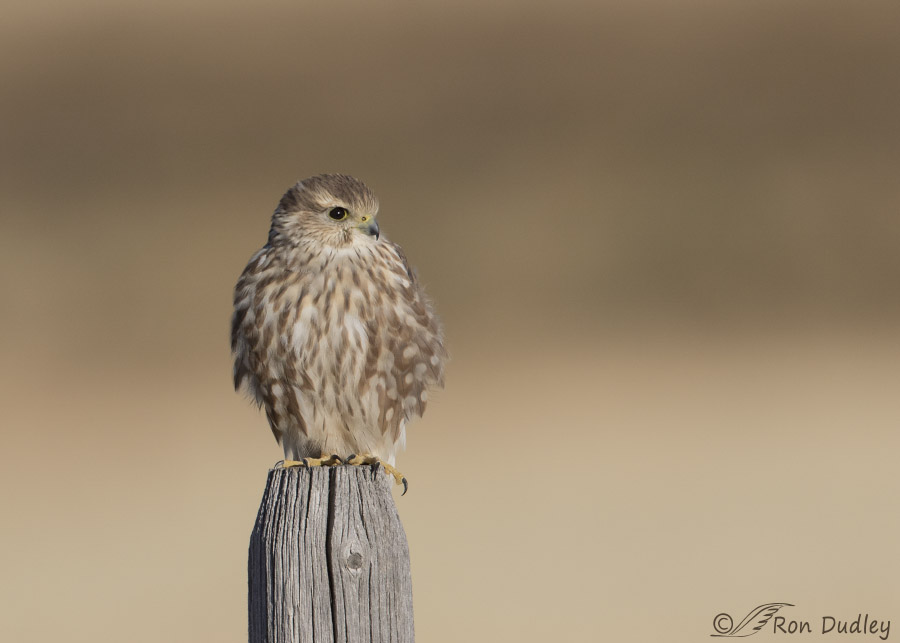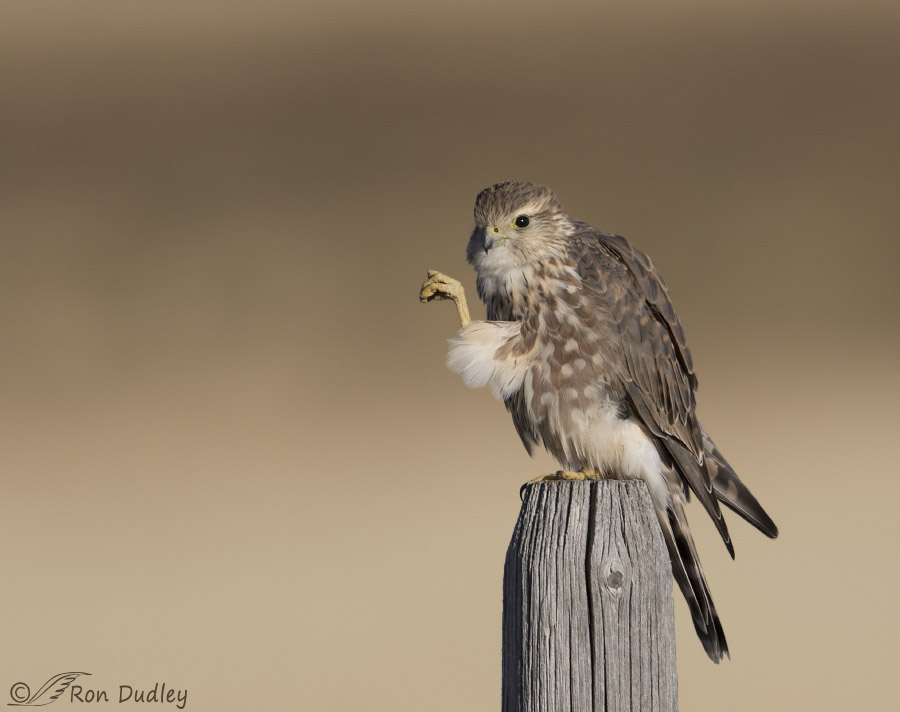I’ve had relatively few opportunities with Merlins but this one gave me several.

1/2000, f/8, ISO 500, Canon 7D Mark II, Canon EF500mm f/4L IS II USM +1.4 tc, not baited, set up or called in
I believe it to be a female of the prairie subspecies (Falco columbarius richardsonii) and I was able to photograph her last week on multiple occasions over several days along the same section of the South Road in Montana’s Centennial Valley. She was always hunting from fence posts (perch hunting is their most common hunting technique) and even though the fences in that area are a mix of old wood and ugly metal fence posts, without exception she always chose one of the larger wooden posts to perch on (which I was grateful for).
I couldn’t help but compare the behavior of this bird to that of its close cousin the American Kestrel. Kestrels seemed to be everywhere in the valley and they also tend to hunt from perches along the road but not one of them let me get close enough for quality images during the week I was there. In contrast, this Merlin (the only one of its species I saw) let me approach and photograph it on five occasions.

1/3200, f/6.3, ISO 500, Canon 7D Mark II, Canon EF500mm f/4L IS II USM +1.4 tc, not baited, set up or called in
And even though she didn’t give me much variety in poses you can see how comfortable she was in my presence as she groomed with her leg up. As is common in many Merlins, this bird lacks the distinct “mustache mark” that is typical of most other North American falcons.
Merlins, only slightly larger than a kestrel, aren’t used much in falconry (read Mark Runnel’s comment below for a modification of that statement) because their small size makes them unsuitable for hawking large quarry but in Medieval Europe they became popular as a “lady’s hawk” and were used in the now classical “ringing flights” (where both prey and pursuer fly in circles as they climb) directed primarily at the Skylark. Mary Queen of Scots and Catherine the Great were enthusiastic practitioners of the sport. These “lark flights” have continued in Great Britain as a tradition but falconers are now under public pressure to stop the practice. In North America a small but enthusiastic group of falconers uses Merlins to fly at quarry ranging from doves to sparrows. They’re too small to take larger prey but their speed and tremendous heart have earned them a loyal following among some falconers.
Ron
PS – I’ve now returned home from my Montana camping trip. The weather and light were wonderful for the entire week I was gone and I found a variety of cooperative birds. Now comes the task of catching up on chores and culling 5K images. Many thanks to my readers for your support while I was gone when I couldn’t respond appropriately to comments. Much appreciated!


Thank you for taking us along… enjoyed all the pics you shared with us and the area descriptions, bird information and equipment/settings used. Enjoyed IT ALL.
Hi Ron
Glad you are back.
I was thinking about those 5K images you have and wonder about what software do you use. Have you heard about FastRawViewer?
I have been told it is one of the best softwares available not only to view but also to culling images.
If you have a little extra time just “google” that name and see it.
Thanks for sharing this beautiful image.
“Have you heard about FastRawViewer?”
No, I hadn’t, Jorge but I’ll definitely check it out. Thanks very much for the tip!
What a beauty! So much more chill than their jittery little cousins. I find that the easiest way to tell them apart at a distance — if it flies off, it was a kestrel.
“if it flies off, it was a kestrel.”
Ha, definitely a useful behavior trait for distinguishing them from a distance, Naomi.
Thank you for the great photos and terrific information about this beauty. I know for myself and for others, this info is valuable to get the wonderful story behind each terrific species. You bring great joy to many, Ron, myself being one of the many!!! I’m very grateful!
Thank you very much, Deborah.
What a lovely little creature…….I hope you take satisfaction that through your blog, you bring rare sightings of beauty to those ( like me ) who will never see the creatures in the flesh—thanks !!
I sure do take satisfaction in that, Kris. It’s one of the things that drives my blogging.
Me too Kris. Education, beauty and delight. Every day. Thank you. And your commentators.
What a beautiful bird! I have never seen a Merlin, but based on your experience with them (and my love for their close relative), I’m sure I would really enjoy them. This one looks like she has a great personality.
She was really quite calm and not very animated, Susan. So very different from kestrels…
What happened to the tea cup she was holding?
She finished her tea and just dropped it, Patty…
Do you think she is posing for you Ron??
Very nice shots of an elusive, at least around here, falcon! We have one or two sightings a year, but they never give me enough time to grab my camera!!
Thanks for the post, very interesting stuff!
“Do you think she is posing for you Ron??”
Nope, she was just grooming some of the feathers on her flank and raised her foot to do so. Then she looked at me for a moment, I fired off a burst, and she went right back to her business. Thank you, Dick.
Hi Ron,
Great catch light and poses in both images and the gradient background is outstanding as well. Looks like these were during the same session, yes?
Thanks, Neil. Yes, both shots are from the same session. I liked the background and light best when the bird was on this perch.
Wow what a lovely little hawk!! I can see why they would be a great choice as a “lady’s hawk”. My favorite of the 2 is your 1st photo but I chuckled at the second. Even though you know she was grooming herself, the photo looks like she was waving “Hello” to you, Ron!! It must have been hard to come back home when you were having such wonderful experiences on your trip. And now we’ll get the rewards of seeing all your captures & the stories behind them!!
It’s always sad to leave the valley, Jo Ann – especially when it’s the last trip of the season. But it’s also good to be home again. Thank you.
Love the first shot. What a beauty. Glad you are back safe and sound.
“Glad you are back safe and sound”
Thanks, Jean – me too. Hauling that trailer that far is always an adventure.
I would love to learn falconry to work with a Kestrel or a Merlin. It may sound mean, but I would use the bird to trim down the doves in my yard. The darn birds are so aggressive at the feeders!
Arwen, I know what you mean – doves are often extremely aggressive at feeders. However, “learning falconry” is a major undertaking – to the point that it’s typically a significant lifestyle change and once most folks realize how much is involved they aren’t willing to make the commitment.
Absolutely. I owned large parrots and know what a commitment they are. So I think I will maybe see if there is a falconer in my area who would like to exercise his bird.
Arwen, I’m with you on decreasing the doves. The White-winged Doves we have here are really obnoxious. One of my all-time favorite bird observations was the time a horny male White-winged Dove was ‘interested’ in a male American Kestrel that had just barely fledged (first day flying). The Kestrel took it for a short time and then went after the Dove to express its annoyance… Kestrel’s are definitely born feisty and opinionated. It would probably be fun to work with one.
What wonderful shots Ron, thanks for sharing! Glad you had great light and weather. Can’t wait to see your portfolio.
Charlotte
Thanks, Charlotte. As is typical with bird photography most of those 5K images are junk and will be deleted but there should be a few good ones among them.
Hi Ron, Merlins are very popular in falconry today. As the wide open spaces become fewer and further between, there has been a major shift in falconry. There is a gradual shift away from Gyrfalcons, Peregrines, and Goshawks hunting Ducks, Pheasants, etc. towards Merlins, Sharpshins, and Aplomados hunting starlings, sparrows, and pigeons in urban and suburban settings.
Merlins are highly prized for their calm demeanor and aggressive hunting style. They are typically captive bred, or wild caught, hunted for one season, and returned to the wild, healthier, and more fit for survival than if they had never met humans.
Thanks for the great blog. I really enjoy my morning “bird fix”
Mark
Thanks, Mark. I always appreciate your knowledgeable falconry input. From my research it didn’t seem like they were quite so popular but as you say falconry is a sport in flux.
For those readers who are unaware, Mark Runnels is a Master Falconer and really knows his stuff.
Cute little devil – devil probably being the operative word if one is prey! Appreciate the info on the bird also
Appreciate the info on the bird also
Thank you, Judy.